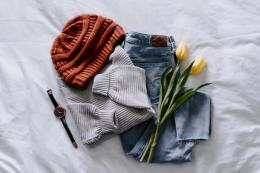How To Start A Profitable Sustainable Fashion Business: A Step-by-Step Guide

By Wildr Editor

Venturing into the sustainable fashion business can feel like an intimidating endeavor, given its intricate nature. Believe us when we say, we've been in those very shoes you're in now (haha).
Armed with valuable knowledge from exhaustive research and hands-on experience in this arena, for instance, did you know that the colossal $3 trillion fashion industry provides employment to more than 3 billion individuals globally?
This blog is your compass, offering practical advice to steer you through your exhilarating expedition of building a successful and profitable venture in sustainable fashion.
So let's get started on this exciting journey!
Understanding the Fashion Industry and Its Impact on the Environment
The fashion industry is huge, making about $3 trillion every year. This money comes from the hard work of over 3 billion people around the world. But, all this size and success has a cost.
The clothing business hurts our planet in many ways. It makes lots of trash and pollution.
We make too many clothes too fast. This is called "fast fashion". Fast fashion gives us new trends to buy all the time but it also creates waste that harms our earth. These fast fashion companies also tend to use toxic chemicals to dye clothes or make them look nice. These chemicals can poison water and harm animals when they're not disposed of properly.
What is Sustainable Fashion?

Sustainable fashion is a movement within the industry that aims to minimize its environmental impact and promote ethical practices throughout the supply chain. It focuses on creating clothing in a way that supports long-term sustainability, from sourcing eco-friendly materials to reducing waste and promoting fair labor conditions.
The market for sustainable fashion has been growing steadily as consumers become more conscious of their environmental footprint and seek out ethically produced clothing options.
Definition of Sustainable Fashion
Sustainable fashion is all about making clothes in a way that is good for the earth and fair to people. It means using methods and materials that protect our planet. It also looks after workers, giving them a safe place to work and good pay.
This type of fashion tries not use things from nature that can't be put back or recycle things we've used before.
It's not just about what goes on inside factories, though. Sustainable fashion also extends to us as buyers, asking us to think more about what we buy, wear it for longer, fix it if it breaks and get rid of it in a way that takes care of the earth when we're done with it.
Ethical and sustainable practices are key in every bit of this process.
The Market for Sustainable Fashion
More people want eco-friendly clothes now. They care about the earth. This is good for a sustainable fashion business, and there's plenty of profit to go around.
Many businesses in this market are doing well because they make clothes that don't hurt our world. We can see an increase in demand for brands that use ethical and sustainable practices, especially among millennials and Gen Z shoppers who prioritize companies that share their values on sustainability issues.
How to Start a Sustainable Fashion Business
To start a sustainable fashion business, you need to build your fashion knowledge, define your sustainability ethics, and source eco-friendly materials.
Building Your Fashion Knowledge
We want to tell you about how you can grow your fashion skills. If you haven't received a university degree in fashion, it's not the end of the world.
First, read a lot of books about fashion and design where you can draw inspiration and ideas from.
The internet will be your best friend when it comes to creativity and learning from those who succeeded before you. You can watch how-to videos online for help.
But nothing beats experience. Try to make some clothes by hand or using a sewing machine, testing out different fabrics and materials, colors, and styles. Note this will require you to invest money and time.
Defining Your Sustainability Ethics
To start a successful and profitable sustainable fashion business, it is important for us to define our sustainability ethics. Here are some key points to consider:
1. Understand the environmental impact of the fashion industry:
- Fashion industry contributes to carbon dioxide emissions and waste generation.
- Fast fashion leads to overconsumption and excessive landfill waste.
2. Embrace ethical production practices:
- Choose suppliers who adhere to fair trade and labor standards.
- Ensure safe working conditions and fair wages for employees.
3. Select sustainable materials:
- Use organic or recycled fabrics like cotton, linen, Tencel, and bamboo.
- Avoid synthetic materials that contribute to microplastic pollution.
4. Reduce waste in the supply chain:
- Minimize fabric waste during production through efficient cutting techniques.
- Implement recycling programs for unused or damaged materials.
5. Promote transparency and traceability:
- Provide customers with information about the origins of your products.
- Seek certifications like Global Organic Textile Standard (GOTS) or Fair Trade Mark.
6. Implement circular economy principles:
- Design garments with durability and longevity in mind.
- Offer repair services or encourage customers to upcycle their clothing.
7. Prioritize responsible packaging:
- Use recyclable or biodegradable packaging materials.
- Minimize the use of plastic trims or accessories.
8. Engage in ongoing sustainability initiatives:
- Stay updated on industry initiatives like the Jeans Redesign program or Sustainable Apparel Coalition.
Sourcing Eco-Friendly Materials
To create a sustainable fashion business, we need to source eco-friendly materials. Here are some important factors to consider:
- Choose suppliers who have control over their supply chain and provide traceability on raw materials.
- Use popular eco-friendly fabrics like organic cotton, linen, Tencel, and bamboo.
- Consider using fabrics made from materials that would otherwise be waste.
- Use recycled and/or biodegradable materials for packaging and shipping.
Need some design inspiration? Check out the Top Eco-friendly Fashion Trends to Watch For
Developing the Concept of Your Sustainable Fashion Brand

In this section, we will explore the creative process of developing your sustainable fashion brand, from designing your brand identity to telling the unique story behind it. Discover how to captivate your target audience and stand out in a competitive market.
Read on to unlock the secrets of successful sustainable fashion branding.
Creating Your Brand Design
Developing a strong brand design is crucial for your sustainable fashion business. Here are some key steps to keep in mind:
- Research your target audience and market trends to understand their preferences and needs.
- Define your brand identity, including your mission, values, and unique selling proposition.
- Choose a memorable brand name that aligns with your sustainability ethos.
- Design a visually appealing logo that represents your brand's personality and values.
- Select a cohesive color palette and typography that reflects the image you want to portray.
- Create consistent brand guidelines for all visual elements, such as fonts, colors, and imagery.
- Develop a compelling brand story that connects with your audience on an emotional level.
- Use sustainable materials for all branding materials, such as packaging and promotional items.
- Incorporate eco-friendly practices into your design process, like using low-impact printing techniques or digital communication methods.
Telling the Story Behind Your Brand
Telling the story behind your brand is really important. It's how you attract customers and show them what your clothing line is all about. When developing a concept for your brand, think about what makes it unique and meaningful.
Consider the values and beliefs that drive your sustainable practices, as well as the inspiration behind your designs. By sharing this story with your customers, you create a connection that goes beyond just buying clothes.
They will understand the purpose behind your brand and feel excited to support it.
Remember to carefully think about your brand identity when telling its story. This includes things like choosing a memorable name, creating a logo or visual representation of your brand, and even registering trademarks to protect it from copying or unauthorized use.
Legal and Strategic Considerations
Choosing the right legal structure for your sustainable fashion business is crucial for its success. A well-drafted business plan will guide your strategic decisions and help you secure funding.
Read on to learn more about these essential considerations!
Choosing the Legal Structure for Your Business
Choosing the right legal structure for your business is important. Here are some options to consider:
- Sole Proprietorship: You have full control and responsibility for your business, but you are personally liable for any debts or liabilities.
- Partnership: You can form a partnership with one or more individuals, sharing the profits and losses. Each partner is personally liable for the partnership's obligations.
- Limited Liability Company (LLC): This offers limited liability protection like a corporation but with less formalities. It allows for flexibility in management and tax benefits.
- Corporation: A separate legal entity that provides limited liability protection, allowing you to raise capital by selling shares of stock. However, it involves more paperwork and formalities.
Drafting a Business Plan
To start a successful and profitable sustainable fashion business, it's important to have a well-drafted business plan. Here are some key considerations:
- Understand Your Market: Research the fashion industry and identify opportunities for sustainability within it. Look for gaps in the market and trends that align with your sustainable values.
- Know Your Target Audience: Define your target audience, such as environmentally conscious consumers who prioritize ethical fashion choices. Understand their preferences, buying habits, and what motivates them to support sustainable brands.
- Develop a Unique Value Proposition: Create a clear and compelling brand identity that sets you apart from competitors. Highlight the unique aspects of your sustainable fashion brand, such as the use of eco-friendly materials or fair trade practices.
- Set Goals and Objectives: Define specific goals for your business, such as sales targets or environmental impact goals. These objectives will guide your decision-making process and help measure your success.
- Outline Your Business Model: Determine how your sustainable fashion business will operate financially. Consider factors like pricing strategy, production costs, distribution channels, and revenue streams.
- Create a Marketing Plan: Develop a marketing strategy tailored to reach your target audience effectively. Utilize social media platforms, influencer collaborations, sustainability events, and partnerships with relevant organizations to raise awareness about your brand.
- Budgeting and Financial Projections: Estimate startup costs, ongoing expenses, and projected revenue streams in order to create a comprehensive financial plan for your business.
- Operational Plans: Detail how you will manage day-to-day operations including sourcing suppliers for eco-friendly materials, establishing production processes that minimize waste, implementing ethical labor practices, managing inventory tracking systems, and ensuring quality control.
- Risk Assessment: Identify potential risks and challenges that may arise in running a sustainable fashion business. Develop strategies to mitigate these risks effectively.
- Monitor Progress: Regularly review your business plan's progress against set goals and adapt strategies as needed. Stay informed about industry trends and emerging sustainable practices to remain competitive.
Securing Funding
Securing funding is crucial for starting a successful sustainable fashion business. Here are some important steps to help you secure the necessary funds:
- Conduct thorough market research to understand your target audience and the demand for sustainable fashion products.
- Develop a comprehensive business plan that outlines your brand concept, financial projections, and marketing strategies.
- Explore different funding options, such as loans, grants, crowdfunding, or seeking investors.
- Build a strong network of industry contacts who can provide guidance and potentially invest in your business.
- Demonstrate your industry knowledge and experience to potential investors by showcasing your understanding of sustainability ethics and practices.
- Emphasize the unique aspects of your brand, such as use of eco - friendly materials or innovative production methods.
- Develop a compelling pitch that highlights the social and environmental impact of your sustainable fashion business.
- Show evidence of customer interest and market validation through pre - orders, sales data, or partnerships with retailers.
Setting Up Your Sustainable Fashion Brand

To set up your sustainable fashion brand, you need to carefully consider the equipment required and create a staffing and recruitment plan. Get some ideas for your fashion line from 15 Best and Sustainable Capsule Wardrobe Brands.
The Equipment Needed
To start your sustainable fashion business, you will need some essential equipment. Here is a list of what you'll need:
- Sewing machines: You'll need reliable sewing machines to create your sustainable fashion designs. Look for models that are energy-efficient and have adjustable settings for different fabrics.
- Cutting tools: Invest in high-quality scissors, rotary cutters, and cutting mats for precise fabric cutting. Choose tools made from recycled or eco-friendly materials if possible.
- Iron and ironing board: An iron and ironing board are necessary for giving your garments a polished look. Consider using an iron that has energy-saving features.
- Pattern making supplies: Get pattern paper, rulers, tape measures, and other tools needed for creating patterns. Look for sustainable options like recycled paper or biodegradable pattern-making materials.
- Quality control equipment: To ensure the quality of your products, invest in equipment like measuring tapes, rulers, and fabric quality testing tools. These will help you maintain consistency in sizing and fabric performance.
- Sustainable packaging materials: Choose eco-friendly packaging materials like recyclable boxes or bags made from sustainable materials. This shows your commitment to sustainability throughout the entire product lifecycle.
Staffing and Recruitment Plan
To build a successful and sustainable fashion brand, it's important to have the right team in place. Here are some key roles you'll need to consider when staffing your business:
- Fashion designers: They will bring your creative vision to life through designing garments and creating unique collections.
- Stylists: They will help curate outfits and create visually appealing looks for marketing campaigns and fashion shows.
- Sales staff: They will interact with customers, provide personalized assistance, and drive sales in physical stores or online platforms.
- Seamstresses: They will be responsible for sewing and constructing the garments, ensuring high-quality craftsmanship.
- Website developers: They will design and maintain your brand's website, ensuring a user-friendly experience for online shoppers.
- Photographers: They will capture high-quality images of your products for promotional materials, social media, and e-commerce platforms.
- Social media experts: They will manage your brand's social media accounts, engaging with followers, creating content, and running effective marketing campaigns.
Marketing Your Sustainable Fashion Brand
Promote your brand launch and create a comprehensive marketing plan to attract customers and build brand awareness.
Promoting Your Brand Launch
To promote your brand launch successfully, here are some effective strategies to reach Millennials and Gen Z:
- Utilize social media platforms: Engage with your target audience through Instagram, TikTok, and Snapchat. Create visually appealing content that showcases your sustainable fashion brand and its unique story.
- Collaborate with influencers: Partner with influencers who align with your brand values. They can help you reach a wider audience and create buzz around your launch.
- Host a launch event: Organize an exclusive event where people can see and experience your sustainable fashion products firsthand. Invite influencers, media personnel, and potential customers to generate excitement.
- Leverage user-generated content: Encourage your followers to share their experiences with your brand by using branded hashtags or participating in challenges. Reposting user-generated content will create social proof and increase brand visibility.
- Offer special promotions: Create limited-time offers or discounts for early adopters of your brand. This incentivizes people to try out your products and increases the chances of word-of-mouth marketing.
- Utilize email marketing: Build an email list of interested customers and send out newsletters with updates about your brand launch, exclusive offers, and behind-the-scenes content.
- Collaborate with like-minded brands: Partnering with other sustainable fashion brands or eco-conscious organizations can help expand your reach while reinforcing your brand values.
- Run targeted online advertisements: Use platforms like Facebook Ads or Google Ads to target specific demographics who are more likely to be interested in sustainable fashion.
Creating a Marketing Plan
To successfully promote your sustainable fashion brand and reach your target audience, you need a well-thought-out marketing plan. Here are some key steps to include:
- Identify your target market: Understand who your ideal customers are and what their preferences and values are when it comes to sustainable fashion.
- Craft your brand message: Develop a clear and compelling message that communicates the unique value of your sustainable fashion brand, focusing on its environmental, social, and ethical aspects.
- Choose the right marketing channels: Determine which platforms and channels will best reach your target audience. Consider social media platforms like Instagram and Facebook, as well as sustainable fashion blogs or websites.
- Utilize influencer marketing: Collaborate with influencers who align with your brand's sustainability values to help spread awareness and generate interest in your products.
- Create engaging content: Produce high-quality content that educates consumers about the importance of sustainable fashion and showcases the benefits of choosing eco-friendly clothing options.
- Implement SEO strategies: Optimize your website and blog content with relevant keywords related to sustainable fashion to improve search engine rankings and increase organic traffic.
- Leverage social media advertising: Use targeted ads on platforms like Instagram or Facebook to reach a wider audience interested in sustainability, especially Millennials and Gen Z.
- Participate in events and collaborations: Attend eco-fashion events or partner with other like-minded brands or organizations to increase visibility for your brand while demonstrating solidarity with the sustainability movement.
- Encourage user-generated content: Encourage customers to share their positive experiences with your products by offering incentives or running contests. Utilize these testimonials as part of your marketing strategy.
- Measure and analyze results: Continuously monitor key metrics such as website traffic, engagement levels, conversions, and sales to assess the effectiveness of different marketing efforts.
Balancing Sustainability with Profitability
In order to run a successful and profitable sustainable fashion business, it's important to find a balance between sustainability and profitability. This means making environmentally friendly choices while still meeting the financial needs of your business.
Adopting a circular economy approach can help minimize waste and maximize resources throughout the product lifecycle.
Starting a successful and profitable sustainable fashion business is an exciting journey that requires knowledge, expertise, and dedication. By understanding the fashion industry's impact on the environment and embracing sustainable practices, you can create a brand that meets consumer demands for ethically produced clothing.
With careful planning, strong branding, and strategic marketing, your sustainable fashion business has the potential to make a positive impact on both the industry and the planet. So go ahead and take these steps to turn your passion for sustainability into a thriving fashion enterprise!



